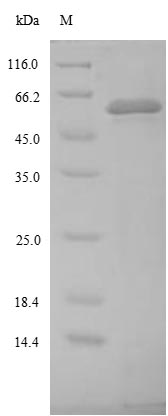Recombinant Saccharomyces cerevisiae Site-specific recombinase Flp (FLP1) is expressed in an E. coli system and comes with an N-terminal 6xHis-tag for straightforward purification and detection. The complete protein spans amino acids 1-423 and shows purity levels above 85% based on SDS-PAGE analysis. This product is intended for research use only and appears to be free of detectable endotoxin levels.
The Flp recombinase protein originates from Saccharomyces cerevisiae and serves as a site-specific recombinase that researchers frequently turn to for DNA sequence manipulation in genetic engineering work. It seems to play a key role in recombination processes by promoting recombination between particular DNA sequences called Flp recombination target (FRT) sites. This specific activity likely makes it a valuable tool for studying gene function and genome editing across different research contexts.
Potential Applications
Note: The applications listed below are based on what we know about this protein's biological functions, published research, and experience from experts in the field. However, we haven't fully tested all of these applications ourselves yet. We'd recommend running some preliminary tests first to make sure they work for your specific research goals.
Based on the provided information, the recombinant Saccharomyces cerevisiae Flp recombinase is expressed in E. coli, a prokaryotic system that is generally unsuitable for producing functional eukaryotic site-specific recombinases. Flp requires precise folding for its DNA-binding and cleavage activities, and while E. coli can express soluble proteins, the complex domain structure and catalytic mechanism of Flp recombinase may not fold correctly without eukaryotic chaperones. The protein is full-length (1-423aa) with an N-terminal 6xHis tag and >85% purity, but the expression system and unverified activity status mean the protein cannot be assumed to be correctly folded or bioactive. Flp recombinase activity requires proper formation of active sites for DNA recognition, cleavage, and strand exchange, which are challenging to achieve in a prokaryotic system.
1. Protein-Protein Interaction Studies via Pull-Down Assays
The N-terminal 6xHis tag enables technical feasibility for pull-down assays. However, if Flp is misfolded (as likely in E. coli), it will not interact physiologically with true binding partners. Recombinases require precise conformation for specific interactions with regulatory proteins and DNA. Identified interactions could be non-physiological artifacts. This application should not be pursued without confirmation of proper folding and DNA-binding activity.
2. Antibody Development and Validation
The recombinant Flp can serve as an effective immunogen for generating antibodies that recognize linear epitopes, even if misfolded. The full-length sequence ensures broad epitope coverage. However, antibodies may not recognize conformational epitopes of properly folded, active Flp in yeast cells. Validation against native Flp from S. cerevisiae is recommended.
3. Biochemical Characterization and Protein Stability Studies
This application is well-suited for assessing the recombinant Saccharomyces cerevisiae Flp recombinase itself. Techniques like circular dichroism spectroscopy, size-exclusion chromatography, and thermal shift assays can evaluate the protein's folding state and stability. These studies are valuable even if the protein is inactive, as they characterize the recombinant product and can inform about its suitability for other applications.
4. In Vitro Binding Assays with DNA Substrates
This application is high-risk without activity validation. If Flp is misfolded, DNA-binding assays will not reflect biological specificity. Flp requires precise conformation for recognizing FRT sites and forming proper nucleoprotein complexes. EMSA or SPR results may show non-specific binding rather than physiological DNA recognition. This application requires prior demonstration of proper folding and specific FRT site binding.
Final Recommendation & Action Plan
Given the high probability of misfolding in E. coli for this complex eukaryotic recombinase, we recommend first performing comprehensive validation: 1) Functional assays using FRT site-containing DNA substrates to test binding specificity and cleavage activity; 2) Biophysical characterization (circular dichroism for secondary structure, analytical ultracentrifugation for oligomeric state) to assess folding quality. Antibody development can proceed immediately as the safest application. Avoid interaction and DNA-binding studies until proper folding and activity are confirmed. For reliable Flp functional studies, obtain the protein from yeast expression systems or use a commercially available validated Flp recombinase. Always include appropriate controls, such as FRT site DNA and known active Flp in experiments.








